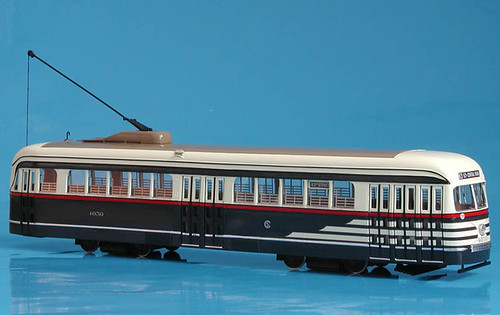
A St. Petersburg Tram Company O Scale model of a Chicago Surface Lines 1936 PCC streamlined streetcar., a photo by Eddie from Chicago on Flickr.
I found this photograph on the internet recently.
The Saint Petersburg Tram Company, is a fine O Scale import company specializing in non operating static models of North American buses and electric streetcars.
One of their more popular offerings, is this model of a Chicago Surface Lines Company (Pre CTA) 1936 vintage streamlined PCC streetcar.
These cars were designed by a group of transit executives in Washington DC operating under the leadership of then U.S President Franklin D. Roosevelt, to lure ridership back to city transit company streetcars across America during The Great Depression era. This group of transit professionals, were known as the President's Conference Commitee. These cars were thus refered to as PCC cars.
Chicago's cars like the model shown here, were delivered in this unique muted blue and cream color scheme, with a red belt rail below the windows. This was known as the CSL's "Blue Goose" color scheme.
The wide broad horizontal stripes across the front, were added by the CSL in 1945, for added safety and visibility in traffic on Chicago's city streets.
Car # 4021 is the only known survivor from Chicago's 1936 fleet of streamlined PCC streetcars that were built by the Saint Louis Car Comapny, and is preserved in inoperable display condition inside one of the barns at The Illinois Railway Museum in the town of Union Illinois USA. www.irm.org
It is displayed in it's original 1936 color scheme.
These cars originally operated on the CSL Rt # 20 Madison Street line when new in 1936.
These 1936 cars also operated on the post 1947 Chicago Transit Authority Rt 63 /63rd Street streetcar line, and the CTA Rt # 4 Cottage Grove line. In 1951, they were repainted in to a simple green and cream color scheme, wich was nicknamed the "Green Hornet" color scheme in honor of a popular comic book superhero. Some local Chicagoans refered to these as the "Green Hornet Streetcars" in later years. During the early years, they were known as "Blue Geese".
Thanks.
Eddie K.
No comments:
Post a Comment